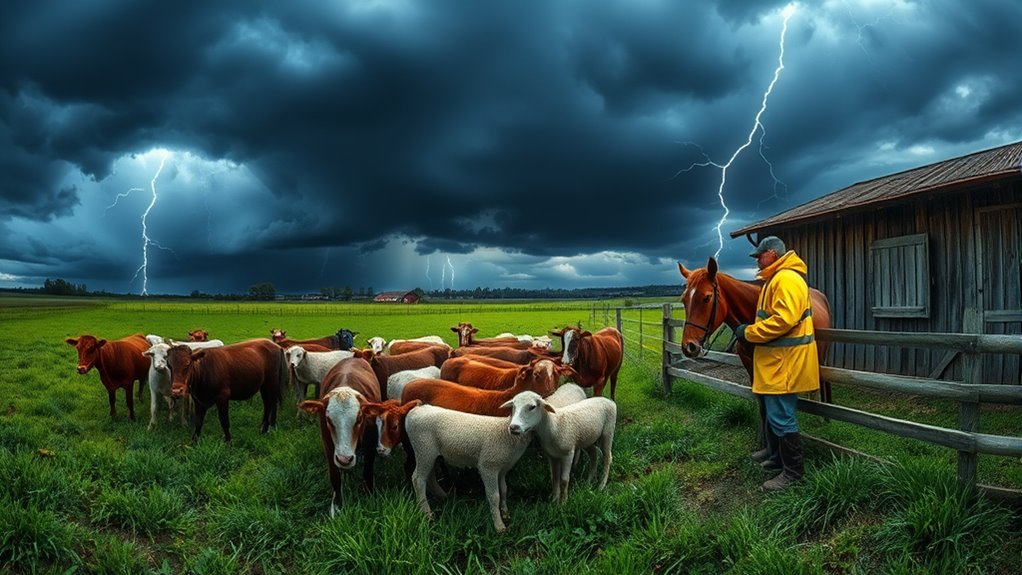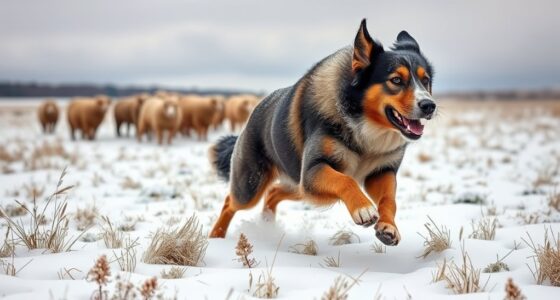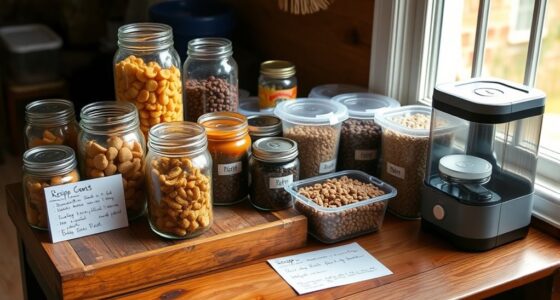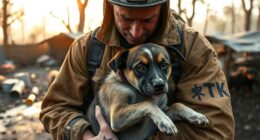To keep livestock calm during storms, focus on reinforcing fences to prevent escapes and designing sturdy, well-ventilated shelters that block wind and noise. Guarantee shelters are accessible, spacious, and cozy with bedding like straw or hay to help animals feel secure. Maintain a calm environment, stick to routines, and communicate gently to reduce panic. With proper preparation, you can create a safer, more reassuring space for your animals during severe weather events.
Key Takeaways
- Ensure livestock are housed in sturdy, well-ventilated shelters with unobstructed entrances for quick refuge.
- Maintain calm leadership and consistent routines to reassure animals during storm events.
- Reinforce fences with supportive materials to prevent escapes and reduce panic.
- Add windbreaks and bedding materials to shelters for comfort and noise reduction.
- Regularly inspect and maintain fencing and shelter integrity to minimize storm-related stress and injuries.
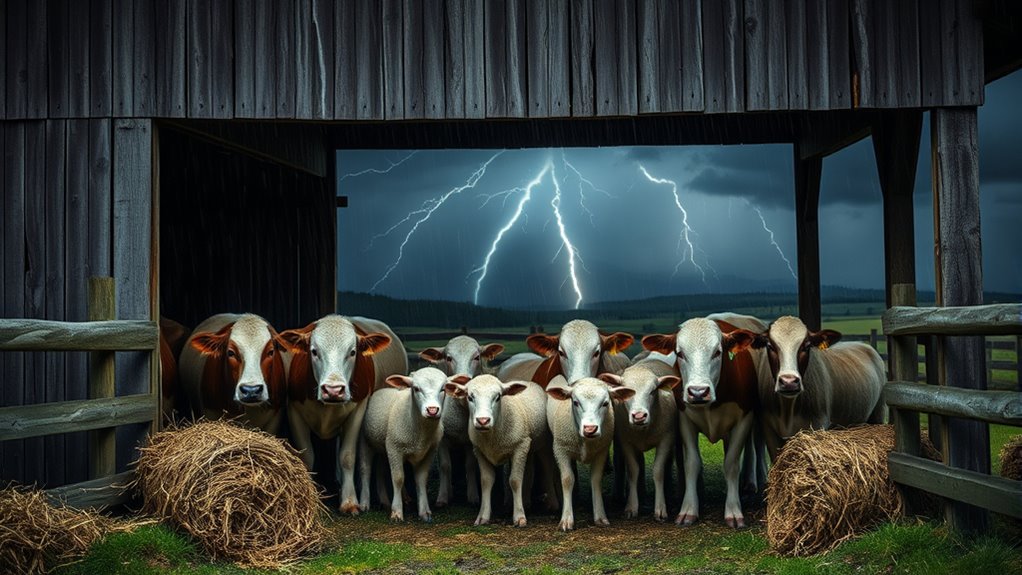
Storms can be stressful for livestock, but with proper preparation, you can help keep them calm and safe. One of the most effective ways to do this is by guaranteeing your fencing is well-reinforced. Strong, secure fences prevent animals from panicking and trying to escape when thunder roars or lightning strikes nearby. Check for any weak spots, loose posts, or gaps that could give livestock an easy way out. Reinforcing fences with sturdy materials like electric wire or additional support posts can give animals a sense of security and reduce the risk of injury if they become frightened and try to push through or jump over the barrier. When fences are solid and reliable, your livestock are less likely to become anxious during a storm, knowing they’re safely contained. Implementing security features in your fencing can further enhance safety and peace of mind during severe weather events.
Reinforce fences with sturdy materials to keep livestock safe and reduce storm-related stress.
Shelter design is equally vital. A properly designed shelter offers a refuge from the elements and helps minimize the stress caused by loud noises, wind, and rain. Make sure your shelters are sturdy and well-ventilated, with enough space for all animals to find a spot that feels secure. Using natural or constructed barriers can help block out the wind and reduce the noise from thunder, which often triggers fear in livestock. Providing a dry, comfortable area also prevents hypothermia and other health issues that can arise during wet, cold storms. Keep in mind that shelters should be accessible and easy to reach before the storm hits, so animals aren’t caught in the open when conditions worsen.
Additionally, think about how the shelter’s entrance is designed. An entrance that’s wide and unobstructed encourages animals to move inside quickly when they sense danger or discomfort. Incorporate features like solid walls or windbreaks around the shelter to further protect your livestock from gusts and flying debris. You might also consider adding bedding materials such as straw or hay, which can provide extra comfort and help animals feel more secure. When livestock have a familiar, comfortable place to retreat to, they’re less likely to panic during storms, which reduces injury and stress.
Finally, your overall management approach during storms matters. Keep calm and communicate clearly with your animals, using familiar routines to help reassure them. Regularly inspecting and maintaining your fencing and shelter design ensures they’re in top shape when storms roll in. By focusing on fence reinforcement and thoughtful shelter design, you create a safer environment where your livestock can weather storms with less fear and more confidence. This proactive approach not only protects your animals but also makes stormy days less stressful for you.
Frequently Asked Questions
How Can I Prevent Livestock From Panicking Before a Storm Arrives?
You can prevent livestock from panicking before a storm by using calming techniques like gentle voices and familiar routines. Keep an eye on weather monitoring updates so you can prepare in advance. Make certain animals are in a secure, comfortable space and avoid sudden movements or loud noises. Consistent, calm handling helps reduce stress, making it easier for your livestock to stay calm as the storm approaches.
Are There Specific Breeds More Resistant to Storm Stress?
Some breeds are more resistant to storm stress due to their breed resilience and genetic traits. For example, Bos indicus cattle tend to handle storms better than Bos taurus breeds because they’re adapted to harsher environments. You should consider choosing animals with strong genetic traits for stress tolerance, as they’re naturally more resilient. Selecting such breeds can help reduce panic during storms and keep your livestock calmer and safer.
What Emergency Supplies Should I Have on Hand for Livestock During Storms?
You should have emergency shelter, sturdy fencing, and extra feed supplies ready for storm preparedness. Keep your livestock’s health records, first aid kits, and clean water accessible. Store flashlights, batteries, and a radio for weather updates. Ensuring quick access to these supplies helps protect your animals and minimizes stress during storms. Being prepared with emergency shelter and essentials makes a big difference in storm response and your livestock’s safety.
How Do I Handle Injured Animals After a Storm Passes?
After the storm passes, you must act swiftly. Spot injured animals quickly, then follow post-storm injury treatment protocols to prevent infection and promote healing. Carefully assess each animal’s condition, providing first aid, and if needed, contact a veterinarian. Your prompt response can make the difference in their recovery. Stay vigilant, as hidden injuries might worsen without immediate care, ensuring every animal has the best chance to recover fully.
Can Soundproofing Barns Help Reduce Livestock Stress During Storms?
Yes, soundproofing barns can help reduce livestock stress during storms. By adding barn insulation and soundproofing materials, you minimize loud noises that frighten animals. This creates a calmer environment, making your livestock feel safer and less anxious. Proper insulation not only dampens storm sounds but also maintains a stable temperature, further promoting comfort. Implementing these measures is a practical way to keep your animals calmer during noisy storm events.
Conclusion
By staying calm yourself and providing a secure shelter, you help keep your livestock calm during storms. For example, a farmer who calmly guided his cattle into a sturdy barn before a thunderstorm noticed they settled quickly, avoiding injury and stress. Remember, your reassurance and preparation make a big difference. With these simple steps, you can protect your animals and keep them safe and calm when weather gets rough.

